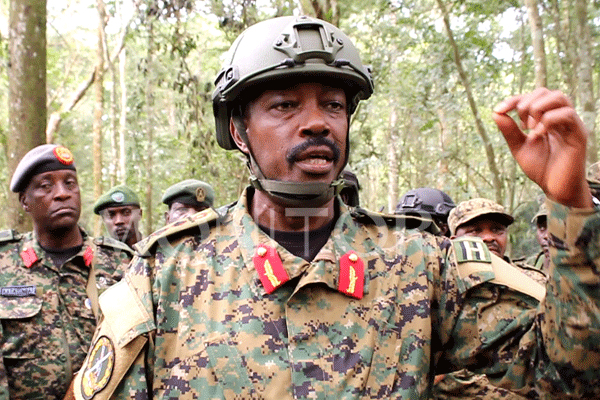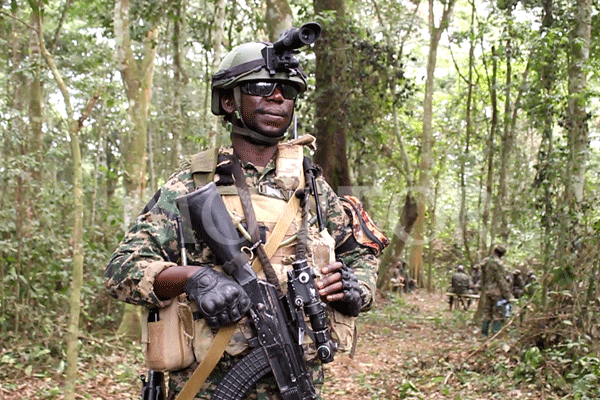Prime
We have bombed ADF seriously, says Maj Gen Kayanja

Lt Gen Kayanja Muhanga, the commander of Operation Shujja, addresses journalists in the jungle of Kambi Ya Yua in DR Congo on December 30, 2021. PHOTO/DAVID BUKENYA
What you need to know:
- On November 30, the UPDF marched into DR Congo soil through the small border town of Lamia in Bundibugyo.
- After six weeks of sustained bombing and counter-guerilla operations in the dense forests of North Kivu, Raymond Mujuni has been granted access to the war frontline embedded with the UPDF.
- This story is the first in a three part series of the UPDF’s war in the Eastern DRC.
For four of the UPDF’s six weeks in the eastern Democratic Republic of Congo, a barrage of bombs rained down small villages and forest thickets. Some precisely targeted camps the army believed belonged to the Allied Democratic Forces.
The government of Uganda accused the ADF of twin bombings in Kampala while others targeted areas where the army thought the group sourced food for their rank and file.
The bombs went over the small towns of Kamango and Kikura and struck Kambi Ya Yua. The UPDF believed, from their planning room, that the village was the home of the leadership of the ADF. It had, from briefing notes they shared with us, more than 640 rebels who were fed through a meticulous system of division of game meat and money earned through gold and cocoa sales.
The UPDF weren’t fighting an entirely new war. In May last year, the DRC government had stomped boots on the ground, suspended the local leadership and placed much of the eastern DRC under a ‘state of siege’. For the rest of the year, its soldiers would run through the dense forests of Ituri and North Kivu in search of ADF militants.
Uganda asked, thrice, in that year, through diplomatic channels to deploy troops into the DRC but the attempts were unsuccessful. Until, in November, when two bombs simultaneously went off in Kampala.
In a short one week, the paperwork between Kinshasa and Kampala would allow for a group of about 2,000 UPDF soldiers to operate in the eastern DRC in a mission that is reviewable every two months.
The job to lead the soldiers fell to Maj Gen Kayanja Muhanga, a battle hardened commander.
Under the cover of darkness, on January 6, Muhanga took a back seat in his lime green Landcruiser.
A motley crew of soldiers led him from the front and covered the back of the car in a convoy. He drove past the Kicwamba Technical Institute, where in 1998 ADF had burnt 80 students and kidnapped 100 others and dipped into the valleys of Ntoroko and Bundibugyo where the UPDF would later chase them to before they fizzled out into the Congo jungles. In the jungles, the rebel force had for two decades survived through recruitment, gold trade and links to Islamist terror organisations, a UN report indicated.
At the Lamia border point, Muhanga switched into an armoured personnel carrier, and with us in the backseat drove into the DRC.
There isn’t much of a road leading to the first camp of the UPDF in Mukakati, which is 14 kilometres into the DRC. A patch work of stones, recently paved dust and half a century old logs, holding fort for bridges, connect the army to its first and most vital camp.
Without the road, the UPDF cannot access the camps that are being barraged with bombs and yet with it, the army has to bear the logistical nightmare of transporting food, weapons and emergency help. To ease the burden, UPDF engineers and their tractors plough the road guarded by soldiers.
“These roads were impassable” Maj Gen Muhanga tells us. “It took soldiers 10 days to move a distance less than 10 kilometres”.
The nightmare of roads continues past the Mukakati camp to Semiliki where the UPDF has built a second camp and worsens from there to Kambi Ya Yua. To get from Semliki to Kambi Ya Yua, the troops have to trek down the valleys and up mountains.
They are supplied food by a helicopter which, is guarded by two other helicopters which are built to detect oncoming missiles.
On our journey in, the sounds of bombs dropping down the forests are unmistakable. Later in the briefing room, Maj Gen Kayanja points to a small village and tells us that the UPDF is concentrating their targets there.
“We have bombed them seriously” he brags.
“Our strategic mission” he says “is to degrade the capacity of the ADF to wage war”.
In the second part we concentrate on the UPDF’s battle plan and how regional politics will affect the operation.



